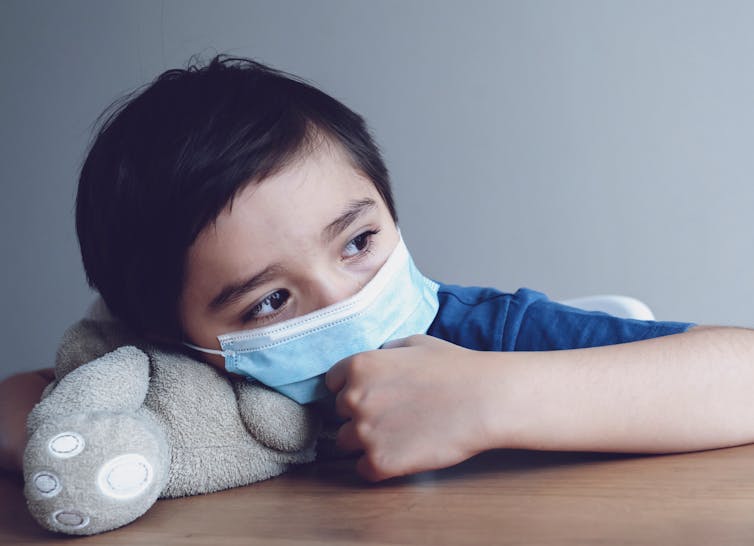
As most parents of teenagers are acutely aware, there comes a time when children start prioritising their friends over their parents. While young children rely on their parents for social interactions and influences, there’s a notable switch during adolescence, where the influence from peers and friends becomes more important.
Research backs up the idea that friendships are particularly important during adolescent years. They seem to protect against some problems with emotions and behaviour. Amazingly, it appears that our brains can even become synchronised with our friends’.
And in our latest study, published in eLife, we show that having roughly five friends during the beginning of adolescence is beneficial for cognition, mental health and educational performance.
Too few friends means that you have no one to interact with if some of them are busy or unavailable and too many friends means that they are probably not very closely connected to you. There is therefore a trade-off between the quantity and quality of friendships.
In addition, spending too much time on social activities may lead to insufficient time for study and thereby may lower academic performance.
Digging into data
Our results are based on a large amount of data from the Adolescent Brain Cognitive Development (ABCD) study cohort, which included 7,512 participants aged 9–11 years olds. The same cohort was followed-up two years later in early adolescence, with data from 4,290 of the participants available. All data was quality controlled.
We found relationships between the number of close friends and mental health, social problems and cognitive measures, including memory, reading and vocabulary. We showed that approximately five close friends was the optimal number – and these associations remained consistent two years later.
At fewer than four or greater than six friends, the advantages reduced. Using a second dataset of over 16,000 adolescents, we confirmed the associations between close friend network size and school attainment as well as wellbeing.
In terms of brain health, we found that the number of close friends was related to the area and volume of the cortex (the outermost layer of the brain). This was specifically within the orbital frontal cortex, anterior cingulate cortex and the temporal parietal junction, which are all involved in the brain’s network for social interactions.
Having five friends was linked to having more volume in these cortical regions. Importantly, these brain regions are also important for other forms of cognition, for example attention and regulating emotions. And we found that people who had found five friends had improved attention and social functioning.
Pandemic impact
But why are social interactions so important for the brain? Wouldn’t we be better at solving problems if we weren’t constantly chatting with our friends? According to one hypothesis, known as the social brain hypothesis, humans have actually evolved to manage complex social relationships. This means that facilitating social relationships is one of the brain’s main tasks.
Schooling was severely affected by the pandemic lockdowns. This is continuing to impact on pupils’ learning according to a UK report by education standards agency Ofsted. In addition to other areas, language – particularly students’ speaking and listening skills – was negatively affected.
But the lockdowns also affected children’s personal development. And young children entering school recently also often lack the interaction skills to share and take turns in class. This may be down to fewer pre-school social experiences with other children.

The Ofsted report ultimately concluded that children do not learn as well remotely. Previous research has shown that in-person interactions help children learn because they make the experience more familiar.
Furthermore, the absence rate at school has increased from pre-pandemic levels. According to a UK government report, persistent absence rates in the 2022/2023 academic year was 22%, up from 10.9% in the 2018/2019 academic year.
Given the importance of social interactions for brain, cognitive and social development, it is essential that adolescents get back into school to engage in academic activities and the social routines which were established prior to the COVID pandemic. This is the best way to promote social cognition, which will in turn boost educational attainment and wellbeing.
Barbara Jacquelyn Sahakian receives funding from the Leverhulme Trust and the Lundbeck Foundation. Her research work is conducted within the NIHR Cambridge Biomedical Research Centre (BRC) Mental Health and Neurodegeneration Themes and the NIHR MedTech and in vitro diagnostic Co-operative (MIC). She consults for Cambridge Cognition. Cambridge Enterprise has technology transferred Decoder to PEAK and PopReach. She receives royalties from PopReach.
Christelle Langley is funded by the Leverhulme Trust. Her research work is conducted within the NIHR Cambridge Biomedical Research Centre (BRC) Mental Health and Neurodegeneration Themes and the NIHR MedTech and in vitro diagnostic Co-operative (MIC).
Chun Shen receives funding from the National Natural Sciences Foundation of China and the China Postdoctoral Science Foundation.
Jianfeng Feng ne travaille pas, ne conseille pas, ne possède pas de parts, ne reçoit pas de fonds d'une organisation qui pourrait tirer profit de cet article, et n'a déclaré aucune autre affiliation que son organisme de recherche.
This article was originally published on The Conversation. Read the original article.







